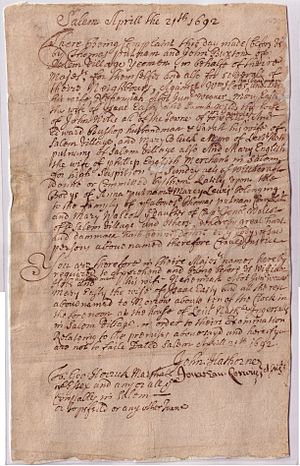Mary Black (Salem witch trials) facts for kids
Mary Black was an African-American woman who was enslaved during the late 1600s. She was owned by Nathaniel Putnam, a member of the well-known Putnam family. Her life took a dramatic turn when she was accused of witchcraft during the Salem witch trials.
The Salem witch trials were a time of great fear and suspicion in colonial Massachusetts. Many people were accused of being witches based on very little evidence. One of the main accusers was Thomas Putnam, who was Nathaniel Putnam's nephew.
Interestingly, Nathaniel did not believe in the accusations. He even defended another accused woman, Rebecca Nurse. Mary was arrested and put in jail, but she was never brought to trial. She was officially released on January 21, 1693 [O.S. January 11, 1692]. After her release, she went back to live and work in Nathaniel's home. This shows that he likely believed she was innocent.
Mary was one of three enslaved people accused of witchcraft during the trials, along with Tituba and Candy. All three of them survived the ordeal.
The Accusation and Arrest
On April 21, 1692, judges John Hathorne and Jonathan Corwin issued an order for Mary Black's arrest. She was accused of using witchcraft to harm several young women, including Ann Putnam, Jr. and Mercy Lewis. The complaint was made by Thomas Putnam and another man named John Buxton.
Several other people were arrested on the same day based on these complaints. They included Sarah Wildes, Sarah and Edward Bishop, and Mary Eastey.
Mary's Examination
After her arrest, Mary had a hearing called an examination. During this hearing, she was questioned about the accusations. The event was recorded by Reverend Samuel Parris.
A strange event happened during the examination. Mary was asked to fix the pin on her neckcloth. As she did this, the "afflicted girls" who had accused her began to act as if they were being pricked with pins. The court records even say that blood was drawn. Despite this strange display, Mary insisted that she was innocent.
Release from Jail
Mary was scheduled to go to trial in January 1693. However, when her case was called, no one came forward to testify against her. Because there were no witnesses, she was set free.
Historians have a few ideas why she was released. One theory is that her owner, Nathaniel Putnam, was a very respected man in the community. People may have been afraid to accuse someone who worked for him. Nathaniel himself did not accuse her. He even paid the fees for her time in jail and welcomed her back into his home.
Another idea is that Mary's accusers were trying to get back at Nathaniel. He had publicly defended Rebecca Nurse, another person accused of witchcraft. By accusing Mary, they might have been trying to cause trouble for him. Accusing an enslaved person was also a way to cause problems for their owner, as enslaved people did not own property that could be taken away.
See also
 In Spanish: Mary Black (Juicios de Salem) para niños
In Spanish: Mary Black (Juicios de Salem) para niños


